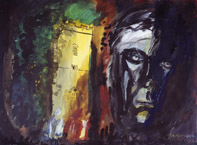Please note that all images on this web site are subject to copyright - no reproduction, copying or other use, electronic or otherwise, is permitted.
The Exhibition
John Piper's fascination with, and care for, church buildings began as a young boy when he produced his own sketches and a guidebook to the churches in his home county of Surrey.
The Second World War had a profound impact on Piper and, as an official War Artist, he produced a collection of paintings of bomb-damaged churches and those in decay. He also became involved in Kenneth Clark's Recording Britain project, which was intended to boost morale by celebrating the country's natural beauty and architectural heritage.
In the years after the war, Piper undertook a series of commissions to create modern stained-glass windows, tapestries and vestments for churches. Some of these were nationally known, such as the Baptistry Window at Coventry Cathedral and the High Altar tapestry at Chichester, others were more personal in nature like the John Betjeman Memorial Window at Farnborough, Berkshire and the Benjamin Britten Memorial Window, Aldeburgh, Suffolk.
His attraction, as an artist, to the architectural details and 'pleasing decay' of church buildings on the outside was matched by a vision to bring colour, energy and modernity into the heart of the church. This passion was to continue for the rest of his life.
An illustrated 64 page catalogue (£15) accompanies the exhibition with written contributions (in order of appearance) by:
- Anne Kelaart
- Patricia Jordan Evans
- Frances Spalding
- Rt. Revd Dr David Stancliffe
- Nicholas Usherwood
- Revd Dr Stephen Laird
- Richard Ingrams
- Revd Nicholas Cranfield
- Simon Martin
- David Fraser Jenkins
- Hugh Fowler-Wright
An extract from David Stancliffe's essay, 'John Piper's Spiritual Landscape', is reproduced below.
Yet the gleams of light continued to break through the gloom, as they had done since his war years. A member of the Oxford Diocesan Advisory Committee for many years, where his eye for what worked to underscore the understated texture of a church was hugely important in its work, John never lost this sense of the particularity of each building. And it is this eye for particularity that gives such an incarnational sense to much of his art. Unlike Graham Sutherland, who was haunted by the crucifixion, Piper was drawn more to the incarnation; much of his figurative stained glass reflects Christmas or Epiphany, where stars and angels inhabit the landscape. And when it came to representing Christ, he is Christ in Majesty and the models are mostly the solid, plastic forms found in the tympana of French Romanesque churches rather than the skeletal gothic forms of the crucified Christ.
But it was not only Romanesque sculpture that formed his eye. Forty years later, in Stained Glass: art or anti-art,5 he could say of the jewel-like watercolour he made of the small lozenge of mediaeval glass depicting the stoning of Stephen (originally from Salisbury Cathedral) in St Leonard's, Grately in 1929, 'On the whole, I learnt more about using colours in making this copy than I have ever learnt before or since.'6 'Writing with hindsight', says Frances Spalding, ‘Piper argued that what made Romanesque stained glass sympathetic to twentieth-century eyes was its use of primary colour contrasts, geometrical arrangements, and the absence of any desire to suggest formal recession.'7
It was initially the striking contrast of light and dark that has opened his eyes to the possibilities of stained glass. 'When I was about ten my father took me to a French cathedral - Notre Dame I think - and I still remember a thrilling shock at the first sight of the stained glass. Light coming through a maze of richly coloured glass in general darkness: what a wonderful idea!'8 This sense of light and dark, this playing out of the primaeval conflict, was, I suspect, what led him to place an extended quotation from Jean Bazaine9 at the start of his 1968 reflection: Stained Glass: art or anti-art.
5
John Piper, Stained Glass: art or anti-art, Studio Vista, London,
1968
6 ibid p. 19
7 Spalding p. 33
8 Foreword to Glass Light (Borehamwood Thorn Lighting, 1978) quoted
by Spalding, p.14
9 Jean Bazaine, Le Vitrail Francais, edition Deux Mondes, 1958







._s.jpg)









